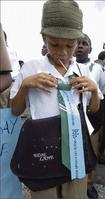
Brad Sutherland, of the New Day Primary and Junior High School, adjusts the Pals ribbon on his tie before the peace march in the community of Grants Pen, organised by the Violence Prevention Alliance in collaboration with the Ministry of Health in February, last year. - Ricardo Makyn/Staff Photographer
IN LOCAL communities affected most by violence, economic and social activities have been considerably reduced. Schools are underpopulated and when there is a flare-up of violence businesses, as well as schools close, the Statistical Institute of Jamaica (STATIN) stated in a 2007 report on violence and its costs.
In 2008, the situation has not changed much. In fact, there has been a deterioration in some areas.
Within schools themselves, the cost of violence and crime is often paid in bloodshed and lost lives.
On Monday, November 27, 2008, 16-year-old Shevon Johnson of the Dunoon Park Technical High School in Kingston was stabbed and killed by a classmate.
numerous incidents
In June, 13-year-old Kenya Kerr, a student of Bethel Town All-Age School in Westmoreland was stabbed to death by another student on the school compound, shortly after classes were dismissed for the day.
These are two among numerous incidents which led to injury or death among students in 2008.
Audrey Pottinger, a consultant clinical psychologist at the Department of Child Guidance attached to the University of the West Indies said that the most frequent and traumatising experiences students have are cruel tea-sing or verbal humiliation, followed by robbery and physical attack. She was making reference to a recent study done with a sample of more than 200 students from primary and secondary schools.
Meanwhile, Dr Herbert Gayle, University of the West Indies-based anthropologist who produced the recent study on early training of males in criminal behaviour, suggested that the Government should invest more in education as one means of reducing crime.
strategies
According to Gayle, United Nations research shows a direct correlation between spending on education and levels of crime.
"In the Caribbean, Barbados has the lowest violence and highest education. Haiti has the highest crime and the lowest education. One of the strategies to get people to participate less in crime is to educate them. Education leads to character building. At the same time, loss of revenue caused by crime means that less can be used on education," Gayle said.
According to Pottinger, "Many children exposed to chronic violence in their community are also beaten regularly at home and school. Feelings of unworthiness, inferiority and low self-esteem were prevalent reports along with expressions of depression. Girls who were shunned or isolated from their peers and boys who were sexually abused were likely to report depression.
"Low self-esteem, identified more in our boys, may be reflecting the disenfranchisement of some children, as they learn from early that they are not worthy of being protected from violence. These students may then 'progress' to delinquent and aggressive behaviours during their adolescent years," Pottinger said.
Pauletta Chevannes, a lecturer in the Department of Education, University of the West Indies, noting that crime continues to impact greatly on the education system, insists that only with wider social change can the problem be solved.
microcosm
"The school is a microcosm of the society and a lot of the violence experienced in these schools is directly related to what is happening in society. The children are seeing it in their communities. Some of the people they are looking up to are involved. They think cheating in the workplace is normal."
Chevannes, a coordinator of an outreach project of the Department of Educational Studies, at the University of the West Indies, aimed at curbing the incidence of violence and antisocial behaviour in schools, noted that of the over 1,000 schools island wide, only a minority are affected by chronic violence.
The educator said that policy-makers should look especially at areas where violence is most manifest (a relatively small number of schools). "Find out where the problem or hotspots exists, what the nature of the violence is, who are the perpetrators, who are the parents, relatives and what are their influences. It can be contained," she added.